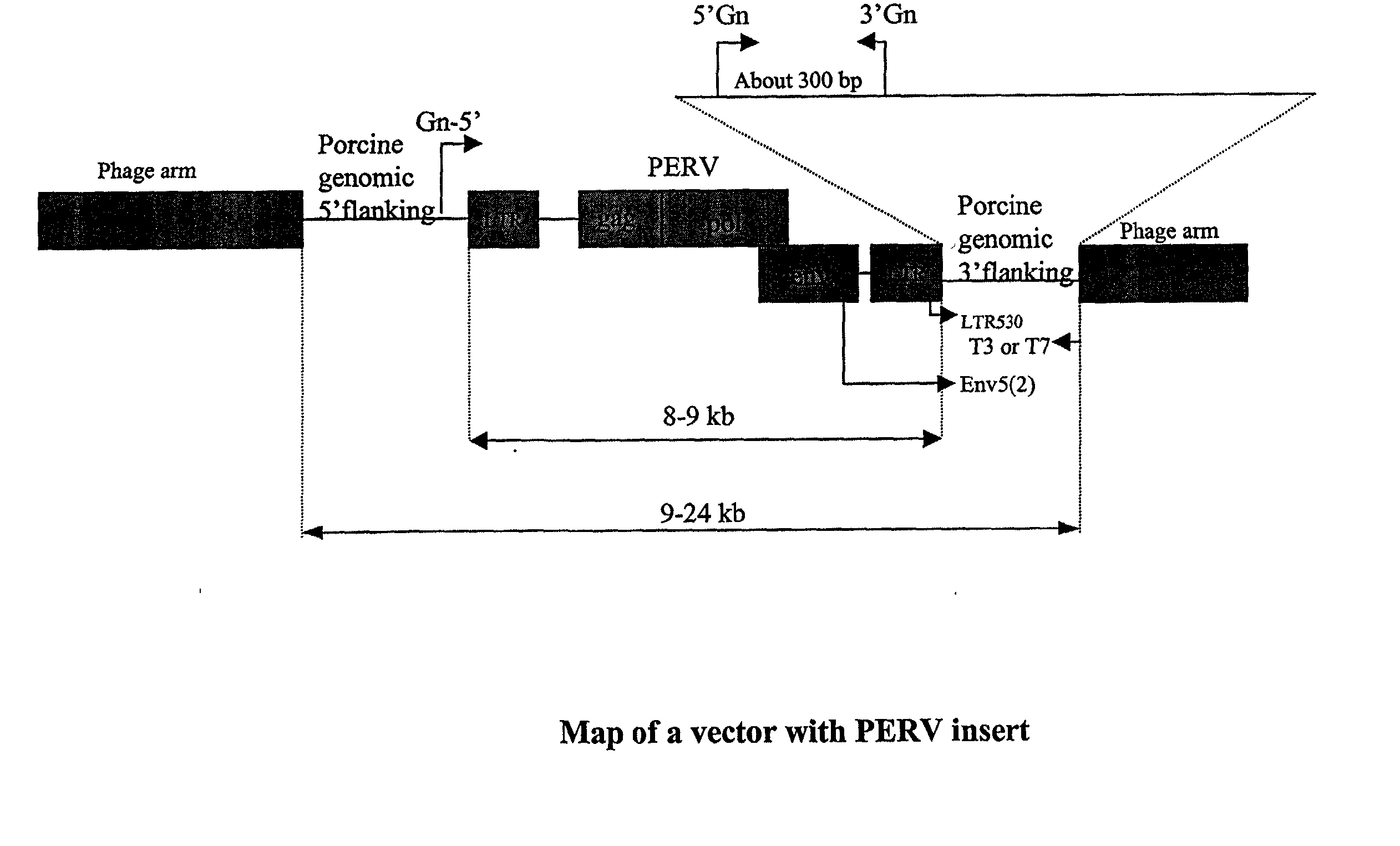Elimination of endogenous porcine retrovirus
a technology of porcine retrovirus and endogenous bacteria, which is applied in the field of compositions and methods for detecting porcine endogenous retrovirus, can solve the problems of insufficient human organs and cells for use as donor tissues, inability to prevent endogenous retrovirus infection, and insufficient perv sequences, etc., to achieve a high degree of sensitivity and specificity, and reduce the chance of false-positive or false-negative results
- Summary
- Abstract
- Description
- Claims
- Application Information
AI Technical Summary
Benefits of technology
Problems solved by technology
Method used
Image
Examples
example 1
[0061] The following is provided for exemplary purposes only and to further aid in the understanding of the invention. As is apparent from the disclosure provided herein, one skilled in the art can make, use or obtain any clone or clones to unique flanking sequences of PERV loci using the methods as exemplified below and described herein.
[0062] Cloning of Unique Flanking Sequences
[0063] Construction of Pig Genomic Library
[0064] All unique 3' flanking sequence and unique 5' flanking sequence clones were isolated from a genomic pig library constructed as follows:
[0065] High molecular weight (>100 kb) genomic liver DNA from a transgenic (CD59 / DAF) male pig (for example, an F2 outcross consisting of Large White, Landrace, and Duroc) was partially digested with Sau3Al, and 9-24 KB fragments were isolated by sucrose gradient ultracentrifugation. The fragments were cloned into a Lambda FIX II vector (Stratagene, Calif.) to construct a pig genomic library.
example 2
[0090] Cloning of a Unique 3' Flanking Sequence, G3-25 (SEQ ID NO: 8)
[0091] The following illustrates how one skilled in the art would make or obtain a PERV clone having a unique 3' flanking sequence. Given the following description and teachings, one skilled in the art can apply the following methods to obtain any PERV clone described herein and is not intended to be limited to isolation of a specific PERV clone. A lambda library was constructed as described in Example 1. A PERV clone was isolated from a lambda FIX II vector using the env-cons probe (SEQ ID NO: 1). In order to distinguish a 3' flanking sequence as distinct and unique (i.e. as a PERV locus), the PERV lambda clone was amplified using the primer pairs env5(2) and T3 or T7 (see FIG. 8) in order to generate a product corresponding from the end of the env region of PERV to porcine genomic sequence flanking the 3' region of PERV LTR. The purified PCR product was then sequenced with the LTR530 (located 100 bp upstream from...
example 3
[0094] Cloning of a Unique 3' Flanking Sequence, G19-A45 (SEQ ID NO: 24)
[0095] The following illustrates how one skilled in the art would make or obtain a PERV clone having a unique 3' flanking sequence. Given the following description and teachings, one skilled in the art can apply the following methods to obtain any PERV clone described herein and is not intended to be limited to isolation of a specific PERV clone. A lambda library was constructed as described in Example 1. A PERV clone was isolated from a lambda FIX II vector using the PERV-A probe (SEQ ID NO: 4). In order to distinguish a 3' flanking sequence as distinct and unique (i.e. as a PERV locus), the PERV lambda clone was amplified using the primer pairs env5(2) and T3 or T7 (see FIG. 8) in order to generate a product corresponding from the end of the env region of PERV to porcine genomic sequence flanking the 3' region of PERV LTR. The purified PCR product was then sequenced with the LTR530 (located 100 bp upstream fro...
PUM
| Property | Measurement | Unit |
|---|---|---|
| Fraction | aaaaa | aaaaa |
| Fraction | aaaaa | aaaaa |
| Fraction | aaaaa | aaaaa |
Abstract
Description
Claims
Application Information
 Login to View More
Login to View More - R&D
- Intellectual Property
- Life Sciences
- Materials
- Tech Scout
- Unparalleled Data Quality
- Higher Quality Content
- 60% Fewer Hallucinations
Browse by: Latest US Patents, China's latest patents, Technical Efficacy Thesaurus, Application Domain, Technology Topic, Popular Technical Reports.
© 2025 PatSnap. All rights reserved.Legal|Privacy policy|Modern Slavery Act Transparency Statement|Sitemap|About US| Contact US: help@patsnap.com



